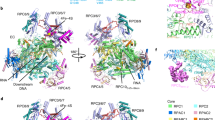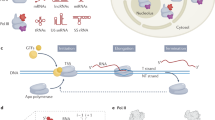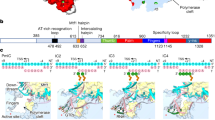Abstract
Here we report the crystal structure of the human mitochondrial RNA polymerase (mtRNAP) transcription elongation complex, determined at 2.65-Å resolution. The structure reveals a 9-bp hybrid formed between the DNA template and the RNA transcript and one turn of DNA both upstream and downstream of the hybrid. Comparisons with the distantly related RNA polymerase (RNAP) from bacteriophage T7 indicates conserved mechanisms for substrate binding and nucleotide incorporation but also strong mechanistic differences. Whereas T7 RNAP refolds during the transition from initiation to elongation, mtRNAP adopts an intermediary conformation that is capable of elongation without refolding. The intercalating hairpin that melts DNA during T7 RNAP initiation separates RNA from DNA during mtRNAP elongation. Newly synthesized RNA exits toward the pentatricopeptide repeat (PPR) domain, a unique feature of mtRNAP with conserved RNA-recognition motifs.
This is a preview of subscription content, access via your institution
Access options
Subscribe to this journal
Receive 12 print issues and online access
$189.00 per year
only $15.75 per issue
Buy this article
- Purchase on Springer Link
- Instant access to full article PDF
Prices may be subject to local taxes which are calculated during checkout





Similar content being viewed by others
References
Masters, B.S., Stohl, L.L. & Clayton, D.A. Yeast mitochondrial RNA polymerase is homologous to those encoded by bacteriophages T3 and T7. Cell 51, 89–99 (1987).
Mercer, T.R. et al. The human mitochondrial transcriptome. Cell 146, 645–658 (2011).
Gaspari, M., Larsson, N.G. & Gustafsson, C.M. The transcription machinery in mammalian mitochondria. Biochim. Biophys. Acta 1659, 148–152 (2004).
Cheetham, G.M. & Steitz, T.A. Structure of a transcribing T7 RNA polymerase initiation complex. Science 286, 2305–2309 (1999).
Ringel, R. et al. Structure of human mitochondrial RNA polymerase. Nature 478, 269–273 (2011).
Temiakov, D. et al. Structural basis for substrate selection by t7 RNA polymerase. Cell 116, 381–391 (2004).
Steitz, T.A. The structural changes of T7 RNA polymerase from transcription initiation to elongation. Curr. Opin. Struct. Biol. 19, 683–690 (2009).
Arnold, J.J., Smidansky, E.D., Moustafa, I.M. & Cameron, C.E. Human mitochondrial RNA polymerase: structure-function, mechanism and inhibition. Biochim. Biophys. Acta 1819, 948–960 (2012).
Yin, Y.W. & Steitz, T.A. The structural mechanism of translocation and helicase activity in T7 RNA polymerase. Cell 116, 393–404 (2004).
Basu, R.S. & Murakami, K.S. Watching the bacteriophage N4 RNA polymerase transcription by time-dependent soak-trigger-freeze X-ray crystallography. J. Biol. Chem. 288, 3305–3311 (2013).
Kostyuk, D.A. et al. Mutants of T7 RNA polymerase that are able to synthesize both RNA and DNA. FEBS Lett. 369, 165–168 (1995).
Sousa, R. & Padilla, R. A mutant T7 RNA polymerase as a DNA polymerase. EMBO J. 14, 4609–4621 (1995).
Brieba, L.G., Gopal, V. & Sousa, R. Scanning mutagenesis reveals roles for helix n of the bacteriophage T7 RNA polymerase thumb subdomain in transcription complex stability, pausing, and termination. J. Biol. Chem. 276, 10306–10313 (2001).
Mentesana, P.E., Chin-Bow, S.T., Sousa, R. & McAllister, W.T. Characterization of halted T7 RNA polymerase elongation complexes reveals multiple factors that contribute to stability. J. Mol. Biol. 302, 1049–1062 (2000).
Durniak, K.J., Bailey, S. & Steitz, T.A. The structure of a transcribing T7 RNA polymerase in transition from initiation to elongation. Science 322, 553–557 (2008).
Yin, Y.W. & Steitz, T.A. Structural basis for the transition from initiation to elongation transcription in T7 RNA polymerase. Science 298, 1387–1395 (2002).
Tahirov, T.H. et al. Structure of a T7 RNA polymerase elongation complex at 2.9 A resolution. Nature 420, 43–50 (2002).
Gnatt, A.L., Cramer, P., Fu, J., Bushnell, D.A. & Kornberg, R.D. Structural basis of transcription: an RNA polymerase II elongation complex at 3.3 A resolution. Science 292, 1876–1882 (2001).
Kettenberger, H., Armache, K.J. & Cramer, P. Complete RNA polymerase II elongation complex structure and its interactions with NTP and TFIIS. Mol. Cell 16, 955–965 (2004).
Schmitz-Linneweber, C. & Small, I. Pentatricopeptide repeat proteins: a socket set for organelle gene expression. Trends Plant Sci. 13, 663–670 (2008).
Nayak, D., Guo, Q. & Sousa, R. A promoter recognition mechanism common to yeast mitochondrial and phage T7 RNA polymerases. J. Biol. Chem. 284, 13641–13647 (2009).
Velazquez, G., Guo, Q., Wang, L., Brieba, L.G. & Sousa, R. Conservation of promoter melting mechanisms in divergent regions of the single-subunit RNA polymerases. Biochemistry 51, 3901–3910 (2012).
Gray, M.W. Mitochondrial evolution. Cold Spring Harb. Perspect. Biol. 4, a011403 (2012).
Litonin, D. et al. Human mitochondrial transcription revisited: only TFAM and TFB2M are required for transcription of the mitochondrial genes in vitro. J. Biol. Chem. 285, 18129–18133 (2010).
Deshpande, A.P. & Patel, S.S. Mechanism of transcription initiation by the yeast mitochondrial RNA polymerase. Biochim. Biophys. Acta 1819, 930–938 (2012).
Campbell, C.T., Kolesar, J.E. & Kaufman, B.A. Mitochondrial transcription factor A regulates mitochondrial transcription initiation, DNA packaging, and genome copy number. Biochim. Biophys. Acta 1819, 921–929 (2012).
Rubio-Cosials, A. et al. Human mitochondrial transcription factor A induces a U-turn structure in the light strand promoter. Nat. Struct. Mol. Biol. 18, 1281–1289 (2011).
Ngo, H.B., Kaiser, J.T. & Chan, D.C. The mitochondrial transcription and packaging factor Tfam imposes a U-turn on mitochondrial DNA. Nat. Struct. Mol. Biol. 18, 1290–1296 (2011).
Falkenberg, M. et al. Mitochondrial transcription factors B1 and B2 activate transcription of human mtDNA. Nat. Genet. 31, 289–294 (2002).
Sologub, M., Litonin, D., Anikin, M., Mustaev, A. & Temiakov, D. TFB2 is a transient component of the catalytic site of the human mitochondrial RNA polymerase. Cell 139, 934–944 (2009).
Mangus, D.A., Jang, S.H. & Jaehning, J.A. Release of the yeast mitochondrial RNA polymerase specificity factor from transcription complexes. J. Biol. Chem. 269, 26568–26574 (1994).
Gnatt, A.L., Cramer, P., Fu, J., Bushnell, D.A. & Kornberg, R.D. Structural basis of transcription: an RNA polymerase II elongation complex at 3.3 A resolution. Science 292, 1876–1882 (2001).
Yin, Y.W. & Steitz, T.A. Structural basis for the transition from initiation to elongation transcription in T7 RNA polymerase. Science 298, 1387–1395 (2002).
Collaborative Computational Project, Number 4. The CCP4 suite: programs for protein crystallography. Acta Crystallogr. D Biol. Crystallogr. 50, 760–763 (1994).
Karplus, P.A. & Diederichs, K. Linking crystallographic model and data quality. Science 336, 1030–1033 (2012).
Broennimann, C. et al. The PILATUS 1M detector. J. Synchrotron Radiat. 13, 120–130 (2006).
McCoy, A.J., Grosse-Kunstleve, R.W., Storoni, L.C. & Read, R.J. Likelihood-enhanced fast translation functions. Acta Crystallogr. D Biol. Crystallogr. 61, 458–464 (2005).
Afonine, P.V., Grosse-Kunstleve, R.W. & Adams, P.D. A robust bulk-solvent correction and anisotropic scaling procedure. Acta Crystallogr. D Biol. Crystallogr. 61, 850–855 (2005).
Emsley, P. & Cowtan, K. Coot: model-building tools for molecular graphics. Acta Crystallogr. D Biol. Crystallogr. 60, 2126–2132 (2004).
Temiakov, D., Anikin, M. & McAllister, W.T. Characterization of T7 RNA polymerase transcription complexes assembled on nucleic acid scaffolds. J. Biol. Chem. 277, 47035–47043 (2002).
Acknowledgements
We thank the crystallization facility at the Max Planck Institute of Biochemistry. Part of this work was performed at the Swiss Light Source at the Paul Scherrer Institut, Villigen, Switzerland. P.C. was supported by the Deutsche Forschungsgemeinschaft, (Sonderforschungsbereich 646 and 960, Transregio 5, Graduiertenkolleg 1721, Center for Integrated Protein Science Munich, Nanosystems Initiative Munich, Graduate School for Quantitative Biosciences Munich), the Bavarian Center for Molecular Biosystems, the BioImaging Network, an Advanced Grant of the European Research Council, the Jung-Stiftung and the Vallee Foundation. D.T. was supported by the US National Institutes of Health (RO1GM104231) and the Foundation of University of Medicine and Dentistry of New Jersey grant PC88-12.
Author information
Authors and Affiliations
Contributions
K.A. and Y.I.M. cloned mtRNAP variants and performed biochemical assays. D.T. and K.S. performed RNAP purification and prepared crystals. K.S. and A.C.M.C. performed structure determination and modeling. D.T. and P.C. designed and supervised research. K.S., A.C.M.C., D.T. and P.C. wrote the manuscript.
Corresponding authors
Ethics declarations
Competing interests
The authors declare no competing financial interests.
Integrated supplementary information
Supplementary Figure 1 Activity of mtRNAP elongation complex assembled on nucleic acid scaffolds.
mtRNAP (1 mM) was pre-incubated with the scaffolds indicated (1 mM) for 5 min at room temperature and the 32P-labeled RNA primer extended by addition of 10 mM of adenosine triphosphate (ATP) for 2 min. The products of the reaction were resolved in 20% PAGE containing 6 M urea.
Supplementary Figure 2 Effects of mtRNAP variants on elongation-complex stability.
(a,b) Thumb deletion mtRNAP mutant is processive but forms unstable halted elongation complexes. (a) Processivity of the Δthumb mtRNAP. Run-off transcription assay was performed using PCR template containing the light strand promoter (50 nM) and the indicated amount of WT (lanes 1–3) and Δthumb (lanes 4–6) mtRNAPs and the products of the reactions resolved in 20% PAGE containing 6 M urea. (b) ΔThumb mutant forms an unstable halted elongation complex. The elongation complexes were assembled using R14–TS2–NT2 scaffold and WT or Δthumb mtRNAP. As a control (C) only polymerase was loaded in lanes 1 and 8. (c) Elongation complexes formed with mtRNAP variants that contain a deletion of the intercalating hairpin are sensitive to salt challenge. Elongation complexes were formed using R14–TS2–NT2 scaffold and WT (lanes 1–7) or the intercalating hairpin deletion mutants Δ613–617 (lanes 8–14) and Δ611–618 (lanes 15–21). As a control (C) only polymerase was loaded in lanes 1, 8 and 15.
Supplementary Figure 3 Structure-based sequence alignment and conservation of human mtRNAP (residues 423–1230) and T7 RNAP (residues 63–883, PDB 1QLN).
Secondary structure elements are consecutively labeled in alphabetical order (cylinders, α-helices; arrows, β-strands; lines, loops). Since helix X is commonly named helix O based on a corresponding helix in the Escherichia coli Klenow (KF) fragment41, we maintain this convention during this work. Identical residues are highlighted in dark green, conservative substitutions are shown light green. Color coding for mtRNAP secondary elements is as in Figs. 1, 2, 3.
Supplementary Figure 4 Analysis of cross-linking mapping data.
Cross-linking mapping with NTCB and CNBr (Fig. 4a) was performed using the so-called “single-hit” conditions42,43 i.e. when every mtRNAP molecule is cleaved only once, on average. Thus, the single-hit conditions generate characteristic patterns of the N-terminal and C-terminal cleavage products. As an example, the theoretical pattern of mtRNAP cleavage by NTCB consistent with the position of the cross-link at the C-terminus is presented above. The size of the labeled fragments is identified by its mass (mobility in SDS-PAGE) using SeeBlue protein standard markers (Invitrogen). To distinguish between the C-terminal and the N-terminal location of the cross-link two variants of mtRNAP were used, WT mtRNAP and Δ104 mtRNAP (Fig. 4a). No shift in bands migration was observed in SDS-PAGE (Fig. 4a, lanes 2 and 3) confirming the location of the cross-link site at the C-terminus of mtRNAP. The smallest labeled band visible on the SDS-PAGE upon NTCB treatment corresponds to the 925–1230 peptide and thus positions the cross-linking site between residues C925 and C1139. This interval was narrowed down even further by CNBr cleavage (Fig. 4a, lanes 5 and 6). The smallest band visible on the gel upon CNBr treatment corresponds to the 1064–1230 peptide and positions the cross-linking site between residues M1063 and M1132. Cross-linking mapping of RNA at base –13 was performed using mtRNAP variants having a single hydroxylamin cleavage site (NG pair) at a defined position (Fig. 4b). The cleavage generates only two mtRNAP fragments simplifying identification of the labeled peptides. Thus the cleavage of the cross-link obtained with NG493 mutant results in appearance of a labeled fragment (83.2 kDa) representing the C-terminus of mtRNAP, while cleavage of NG634 mutant results in appearance of the N-terminal fragment (61.5 kDa). Taken together, these data suggest that the cross-linking site is between residues 494 and 634. Mapping of cross-link at DNA template base at –8 (Fig. 4c) was performed using NH2OH and WT, NG556 and NG634 mtRNAPs. WT mtRNAP contains four sites for NH2OH cleavage at positions 710, 926, 1103 and 1117, however the most N-terminal site (710) is cleaved inefficiently and thus the resulting peptides are not visible. NH2OH cleavage of the mtRNAP-DNA cross-link results in two major products corresponding to the intervals 44–926 and 44–1103 or 44–1117 (Fig. 4c, lane 6). Since no band was observed that corresponds to the interval 926–1103 or 926–1117 (about 28 kDa for peptide with the cross-linked DNA) we conclude that the cross-link is to the 44–926 interval of mtRNAP. Cleavage of the NG556 mutant results in appearance of the labeled C-terminal fragment (around 82 kDa), while cleavage of NG634 mutant generates two labeled fragments representing both the C- and the N-terminal parts of mtRNAP (Fig. 4c, lanes 1–4). Taken together these data suggest that the cross-link site of –8 base of DNA includes two adjacent mtRNAP regions: 557–634 and 635–926.
Supplementary information
Supplementary Text and Figures
Supplementary Figures 1–5 and Supplementary Tables 1 and 2 (PDF 3322 kb)
Animation of the structural rearrangements between apo-mtRNAP (PDB 3SPA) and its elongation complex.
The movie was generated using the morphing function of UCSF Chimera48. (MOV 3770 kb)
Rights and permissions
About this article
Cite this article
Schwinghammer, K., Cheung, A., Morozov, Y. et al. Structure of human mitochondrial RNA polymerase elongation complex. Nat Struct Mol Biol 20, 1298–1303 (2013). https://doi.org/10.1038/nsmb.2683
Received:
Accepted:
Published:
Issue Date:
DOI: https://doi.org/10.1038/nsmb.2683
This article is cited by
-
Mechanisms and regulation of human mitochondrial transcription
Nature Reviews Molecular Cell Biology (2024)
-
POLRMT mutations impair mitochondrial transcription causing neurological disease
Nature Communications (2021)
-
The replication machinery of LUCA: common origin of DNA replication and transcription
BMC Biology (2020)
-
The dynamic landscape of transcription initiation in yeast mitochondria
Nature Communications (2020)
-
Small-molecule inhibitors of human mitochondrial DNA transcription
Nature (2020)



